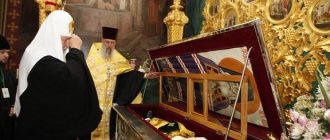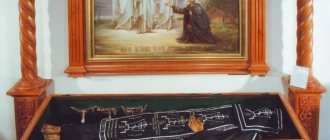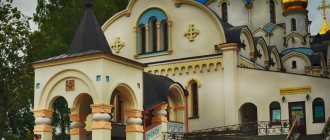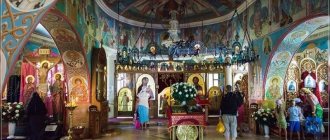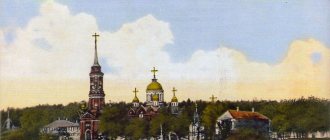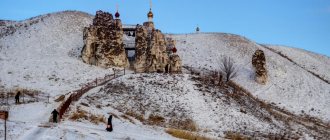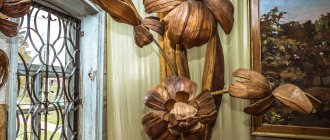Story
Appeared in 392 on the island of Cyprus. A legend placed in the Greek synaxarion for the week of Orthodoxy, and usually associated with this icon, says that the holy image stood on the gate leading to one church of the Most Holy Theotokos (the Church of Panagia Angeloktista). One day an Arabian, driving past this church, wanted to mock the Christian shrine. He shot an arrow at the image and hit the knee of the Most Holy Theotokos in the icon. At that very moment, blood flowed from the wound in such quantities that it stained the ground. The Arabian rushed to gallop home in horror, but before reaching home, he fell dead on the way.
Since ancient times, the Cypriot icon has been kept in the Stavruni monastery, which, according to legend, was built at the place where it was found.
Honored miraculous lists
| Cyprus Icon of the Mother of God in the village of Stromyni |
Stromynsky
The most famous copy of the Cypriot icon in Russia was located in the village of Stromyn, not far from Moscow, in the Bogorodsky district. The icon measures 1 arshin and 4 inches in height, and 1 arshin and 2 inches in width. The Mother of God is depicted wearing a crown and sitting on a throne; at the top near Her there are angels on each side, one on each side, wearing crowns with branches; below are kneeling - on one side is the martyr Antipas, on the other is the martyr Photinia. About the origin of the icon, during the inquiry in 1841, it was found out that “according to church inventories, it was listed in 1783 in the abolished wooden St. Nicholas Church, behind the left choir, and in 1823 in a high place in the Sergius chapel of that church. When the St. Nicholas wooden church was dismantled in 1829, the Cyprus Icon of the Mother of God was placed on the porch of the newly built stone church above the entrance doors.” Here, in the Assumption Church, this copy of the Cypriot icon became famous in 1841.
At that time, the 18-year-old daughter of a peasant in the village of Stromyni, named Marfa, fell ill with scrofula and scrofula. The disease began to intensify over time. At the beginning of 1841, her seizures became so severe that they threatened her life. Martha's relatives and friends were already sure of her imminent death; On January 7, the sick woman was confessed and received the Holy Mysteries of Christ. But the merciful Lord did not allow her death. The Cyprus Icon of the Mother of God, standing on the porch above the entrance to their parish church, began to appear to her in a dream. From the icon, Martha heard a voice telling her: “Take Me to your house, serve a prayer service with the blessing of water, and you will be healthy.” She told her family and friends about her dreams. More than once she asked the priest and clergy about this icon, but they could not find it, since they almost never paid attention to its location. Then they brought the sick woman to the church so that she herself could find the icon she had seen. Her search for a long time was not crowned with success, until, finally, she went out onto the porch and saw an ancient icon of the Virgin Mary above the church doors. Noticing the icon, the patient joyfully exclaimed: “Here it is!” On February 16, the sick father invited a priest to his house with an icon of the Mother of God. After the prayer service with the blessing of water was served, the patient immediately felt relief. Her strength became so strong that after the prayer service she herself carried the icon of the Mother of God to the church. Soon she finally recovered.
When the residents of the village of Stromyn heard about the miraculous healing, they began to come to the church in large numbers to serve prayers before the famous icon. Graceful power emanated from her and healed those who, with humility and hope for the intercession of the Mother of God before God, brought their prayers to her. Not only parishioners of the village of Stromyni, but also residents of the surrounding areas began to flock here. Healings of paralysis and relaxation have been witnessed.
The priest of the Assumption Church reported all these miracles and the popular veneration of the icon to the Moscow Metropolitan, Saint Philaret, who ordered that a search be made about the image, place the icon in a decent place, not prohibit prayer services, and report weekly on the events taking place. In the winter and autumn of 1841, the flow of people to the icon began to decrease and Metropolitan Philaret ordered the local dean to stop weekly reports, excluding special cases. Since then, the Cyprus-Stromynsk Icon of the Mother of God remained in its place, and through prayers miraculous help continued to be given to it for those who came with sincere faith. The icon was decorated with a rich silver-gilded chasuble. In the church of the village of Stromyn, this icon was also celebrated on February 16 - the day of the healing of the maiden Martha.
Nizhny Novgorod
Celebration of May 12
The Mother of God is depicted sitting on a throne; Her head is decorated with a royal crown. The Eternal Child is represented with his head uncovered, while His right hand blesses.
The Cyprus Icon of the Mother of God, located in Nizhny Novgorod in the Church of St. John the Baptist, which became famous for many miracles in Slobodka. Through prayers before her, the pestilence in Nizhny Novgorod, which raged there in 1771, stopped. Residents of the city took the holy icon into their homes, performed prayer services in front of it and received healings.
Other lists
In Russia, there are also known copies of the Cyprus Icon of the Mother of God located in the Moscow Church of St. Nicholas in Golutvin and in the Moscow Assumption Cathedral near the left pillar. The latter depicts the Mother of God with the Eternal Child, and below is an orb; This icon was decorated with a rich frame.
Sacred and most interesting places in the Nizhny Novgorod region
In the Nizhny Novgorod region there are unique, unusual, sacred and mysterious places. The most famous of them are located near the Tatar villages of the Krasnooktyabrsky and Sergachsky districts.
1. Yalgyz agach (Lonely tree) / “Sacred elm Kurgonsat” . (located near the village of Kochki-Pozharki)
One of the shrines of the Sergach Tatars, who call it “The Sacred Elm Kurgonsat” or “The Terrible Tree Kurgonsat” and, indeed, it inspires some kind of fear, and it is considered one of the mystical places in the Nizhny Novgorod region. Many Tatar legends and traditions are associated with it.
Local residents consider it necessary to take care of the trees planted by the hands of their ancestors: “These trees are holy - their great-grandfather planted them, putting pieces of paper with prayers under them, when you come up, you will pray, you will remember your ancestor.” And they scared the children: “If you break a branch, your hand will wither.” Read more, “The Sacred Elm Kurgonsat” (Kochko-Pozharki village)
2.“Keremet” sacred spring (village Kochko-Pozharki).
The Keremet spring is located on the outskirts of the village of Kochko-Pozharki and is widely known among the Tatars of the Sergach region as a sacred place and one of the best sources of mineral water with equipment for its collection. Cleanliness and order are maintained around the source.
Tract. In the half-mountain there are two outcrops of calcareous rocks in the form of slabs measuring 2 x 1 and 5 x 2 m inclined at the angle of the slope itself. Legend prohibits the use of stone slabs, as it claims that under them there is an underground lake that can flood the valley with the village Kochko-Pozharki.
The spring and the tract, judging by the name and legends, were in ancient times places of traditional rituals, as indicated by the characteristic flat area with ruderal vegetation - the sacrificial places of similar sanctuaries of the Mari and Mordovians look similar. More details, “Keremet” (Kochko-Pozharki village)
3.Taratash stone and sacred willow (Aktukovo village).
The sacred stone Taratash (Tratash) is located on the outskirts of the village of Aktukovo, on the slope of the right bank of the Sukhaya Para River. A metal hexagonal canopy with a gate was built over the stone and the area of meadow around it. Stone is a place of pilgrimage for Nizhny Novgorod Tatars. Prayers are performed on it, and monetary sacrifices are made to it. In the past, according to legend, prayers were held on the mountain above the stone in case of bad weather and livestock illnesses, for which purpose herds were driven there. According to legend, the stone represents a petrified child who was cursed by his mother for disrespect: it is customary to use the stone to scare naughty children.
The sacred willow is located in the center of the cemetery in the north-eastern part of the village and is a monument. Sacred willow Age - 200 years, height 15 m. According to legend, the tree was planted at the end of the 18th century on the grave of the founder of the village.
Monetary sacrifices are brought to the tree with prayer during days of illness or difficult life situations; the tree is carefully protected by local residents. More details, Sacred willow and Taratash stone.
4.Sacred birch (Krasny Yar village).
Krasny Yar is the name given to tracts on the banks of rivers in the old days. The Yar is a steep, elevated bank, and the name red indicates a beautiful location.
Krasny Yar - in the village cemetery there is a Tatar sacred multi-stemmed birch tree, according to legend, planted on the grave of the founder of the village. The tree had an unusual fountain-like shape. Currently, it has collapsed and practically died, apparently due to age and the cataclysms of recent years.
More details, Krasny Yar village.
5.“Iskelekler” and “Azatlyk Chishmase” sacred spring (Chembiley village).
“Iskelekler” is a traditional place for many Muslim rituals.
The Azatlyk Chishmase spring is an interesting natural landmark, covered in legends and revered by the surrounding population.
In 2004, a small house was built here in a beautiful Muslim style, which can be seen from afar from the Republican highway. The water of the Freedom Spring is considered healing. More details, “Iskelekler” and “Azatlyk chishmase” (Chembiley village).
6.Mazarlar Oste and the source “Biksasy” (Shubino village)
Mazarlar Oste. (Holy burials, 1602-1720). Mazar, as is customary in oriental studies, is a concept denoting a place that is visited and which is an object of pilgrimage. This is usually the grave of a Muslim "saint", as well as any other monument of cult or religion, traditionally perceived as a holy place. More details, Mazarlar Oste (Shubino village).
Source "Bixasy" (1640).
The spring is located on a high hill, from which the entire village is clearly visible, with a beautiful panoramic view of the Piana River valley. The water from the Biksasa spring is the most delicious, quenches thirst well and has healing properties.
More details, Source “Biksasy” (Shubino village)
7.Shahidlyar Kabere (Semenovka village)
In the village of Semenovka (Semotski), Krasnooktyabrsky district, Nizhny Novgorod region, a terrible tragedy occurred in January 1919. A detachment of security officers shot more than 50 people without trial or investigation, including 7 imams, ministers of mosques and houses of worship, teachers, and intelligentsia from the nearby Tatar villages of Poshatovo and Semyonovka (the exact number of those executed is unknown).
The Tatar population of the Nizhny Novgorod region preserved in oral tradition the memory of the events of 1919 in Semyonovka, as “violence of Soviet power over the working people” and “persecution of the Tatars and their mullahs for the Islamic faith.”
The victims of the 1919 tragedy were counted among the sufferers for their faith, and their burial place became a place of religious worship. In Soviet times, the care of the mass grave was carried out by residents of the village of Semenovka. On June 19, 1999, a marble stele was installed on the mass grave with the names of 50 victims who died for their faith, their native traditional faith - Islam.
More details, Shahidlyar Kabere (Semenovka village)
8. “Izge kaberleklar” (Holy burials) (Gribanovo village)
The most mysterious and mystical place in the Meshchera region is “Izge kaberleklyar” (Holy burials). According to legends preserved among the residents of the village of Gribanovo,
The warriors of the Tatar Khan Arapsha, who died in the famous Drunken Massacre in 1377, were buried here.
More details, “Izge kaberleklar” (Gribanovo village)
9.Sacred house of Sadek-abzi Abduljalilov (Sheep Ravine village)
The Tatar village of Kui Suy (Sheep Ravine) is the native village of the Sufi sheikh Sadek-abzi Abduljalilov. It was in this village that the most revered holy confessor and healer by the Nizhny Novgorod Tatars was born, lived and worked. The house of saints (elders) (Izgelar Yorty/Abzilar Yorty) , in which the righteous man lived, still exists today, having withstood the years of massive destruction of churches and mosques. He began to be revered immediately after the death of Sadek abzi. Hundreds of people rushed here under the cover of darkness along forest and field paths, risking being arrested and sentenced to many years in prison.
The house of saints is charged with positive energy, it is transmitted to a person and is capable of healing from all sorts of illnesses and emotional distress. Everything that has been in this house is medicinal, the old-timers believe.
Believers of different faiths come to the “house of wishes”: Muslims, Orthodox, and Catholics; many people came from all over the world: from the Czech Republic, Finland, Germany, America, the Baltic states. The saint helps everyone.
More details, Sacred house of Sadek-abzi Abduljalilov (Sheep Ravine village)
10.Holy burials. Holy Well (village Bortsurmany).
Bortsurmany is a village in the Pilninsky district of the Nizhny Novgorod region and arose more than four hundred years ago.
The surviving remains of graves (things, bones, weapons, jewelry) suggest that there was a Tatar cemetery here.
Holy Well.
On the western side of the village, 100 fathoms from the house of landowner Shipilov, there is a well called Holy.
The healing properties have been known to residents for a long time. People from different parts of the world come to the source
Miracles of healing in Bortsurmany.
Initiates have long been creating legends about Bortsurmans and the healings that take place there. It all started more than two centuries ago. At the end of the 18th century, a new priest appeared in the Assumption Church of this village - Alexey Gneushev. As legends say, for his righteous life he received a gift from above. More details, Bortsurmany village.
11.“Silver Keys”, “Decks” healing springs, Yavleika Arboretum (Sergach)
Silver keys.
The Holy Key is located 3 kilometers from Sergach. Old hollow elms used to grow here. According to legend, an icon was found in the hollow of one of the trees, and the source became holy. “Silver Keys” is a later name of the spring.
In Nizhny Novgorod, the chemical composition of water was studied and a significant concentration of silver ions was found; as a result, the water does not spoil for a very long time, being stored for years.
More details, “Silver Keys” (Sergach)
Spring "Decks"
On the high bank of the Sergachka River, not far from the Vladimir Cathedral in the city of Sergach, there is a well-equipped spring “Kolody”. In the 17th century, the small settlement of Sergievka was located here, which gave rise to the village of Sergach, which was soon, in 1779, transformed into a county town.
Above the entrance to the territory of the source, the inscription reads: “Here, Sergach began.”
More details, Source “Deck” (Sergach)
Arboretum Yavleika.
The Sergach Arboretum is located near the center of the city of Sergach, Nizhny Novgorod region, at the northern exit from it, is included in the list of state natural monuments of regional significance and is a favorite vacation spot for many residents of its surroundings.
The name “Yavleika” is a local designation for the hills and ravines along the bottom of which the Yavleiko stream flows; the official name is “Arboretum complex of the Sergach forestry enterprise”, founded in 1986, with a total area of more than 90 hectares.
More details, Arboretum Yavleika (Sergach)
On a note!
Tourists and travelers in Sergach should also visit the local history museum named after V.A. Gromov.
The Museum named after V.A. Gromov has a rich collection on the history of its native land, is the calling card of the city of Sergach, which has a rich historical heritage, and presents household items of the Russian, Mordovian and Tatar peoples who have lived together for centuries.
More details, Museum of Local Lore named after V.A. Gromov (Sergach).
History of Tatar villages of the Nizhny Novgorod region. Nizhgar Tatarlars.
More details, Tatar villages of the Nizhny Novgorod region (list)
